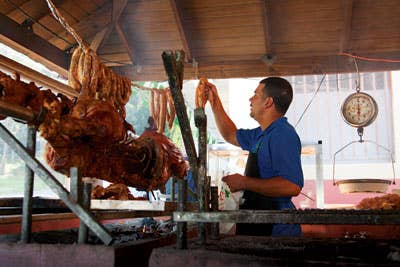
Pork is King
Lechon, roasted young pig (lechon refers to a piglet fed on its mother's milk, or leche), is both an essential part of the holiday table and Puerto Rico's national dish. The preparation of it is considered a time-honored craft, and the method has remained the same for centuries: The carcass of a juvenile pig is first rubbed with adobo spices, a simple blend that includes salt, pepper, and oregano. The seasoning then settles for a day or two, penetrating the skin and meat. The animal, which weighs usually no more than 100 pounds, is tied to a spit and roasted over coals in a steel or cinder block box, frequently turned sideways to release the grease from under the skin. The fat eventually renders out, and the skin, known as cuerito, becomes crackly and paper-thin. Lechoneros then butcher the animal, and every part is consumed; even the innards, which are removed before the pig is roasted, are used to make gandinga, a stew said to soothe hangovers.
Christopher Columbus first introduced pigs to the island on his second voyage to the New World in 1493, adding meat to the vegetarian diet of the indigenous Taino people. Over the centuries, it became common for families to keep a pig, fatten it up over the year, and cook the whole animal come holiday time so it wouldn't have to be fed over the lean winter months. Today, cafeteria-style restaurants known as lechoneras have replaced the family pig. These are humble, open-air eateries where locals go on weekends for feasting and fun, which can include dancing, live music, or competitive games of dominos (another Puerto Rican obsession). In addition to the roasted pigs, lechoneras serve traditional sides, such as arroz con gandules (rice with pigeon peas) and morcilla (blood sausage), as well as drinks, like mavi, a fermented tree bark and sugar elixir.
There are several areas on the island known for their high concentration of lechoneras. The most famous of them, referred to as the Ruta del Lechon, or pork highway, lies 35 minutes outside of San Juan off Carretera 184 in Guavate, a town in the Sierra de Cayey Mountains with more than 20 lechoneras; each has its specialty. El Guavateño (Carretera 184, km. 27.9; 787/314-2433) is the only chef-driven lechonera on the strip. Chef Ricardo Cestero's creative touches include lechon-Manchego empanadas as well as dumplings made with morcilla. At nearby El Rancho Original (Carretera 184, km 27.5; 787/747-7296), the cuerito is especially good, and the atmosphere especially lively—viejos (old-timers) are known to dance the salsa and merengue to live music. At Los Pinos (Carretera 184, km. 27.7; 787/286-1917), the flavorsome, tender pavochon (turkey roasted in the style of lechon) is not to be missed. Yet no matter the lechonera, pork aficionados know to show up early to claim the rare, delicious bits like the ears and tail.
Keep Reading
Continue to Next Story










